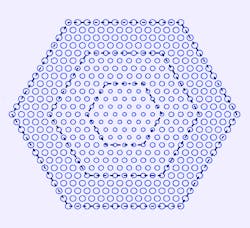Nonlinear Optics: Light-trapping, frequency-doubling photonic crystal is first of its kind
Scaling the size of nonlinear frequency-conversion optics down while boosting their efficiency would allow them to be more easily and widely used in devices ranging from biosensors to spectrometers to quantum optical systems. Frequency conversion of light, such as frequency doubling, is done using a nonlinear optical crystal, usually in bulk form. Miniaturizing this process can be done by replacing the bulk crystal by a photonic crystal (PhC) made out of a nonlinear optical material—however, creating such a doubly resonant device that has a photonic bandgap for both the original and frequency-converted light has been impossible, preventing the design of microscopic frequency converters based on PhCs.
Researchers from Stanford University (Palo Alto, CA) and the Università di Pavia (Pavia, Italy) have developed design guidelines for creating a PhC structure with an unconventional two-part form that solves this problem.1 Rather than trying to create a PhC that achieves double resonance by having two bandgaps, the researchers developed a version that confines the fundamental frequency via a conventional bandgap, while confining the doubled frequency using a “bound state in the continuum” (BIC). Such a state is a single frequency that is localized even though frequencies all around it are unbound—a BIC is a particular type of resonance in which scattering and interference create the bound state.
Efficiency recipe
After ironing out the details of their two-part structure, the researchers produced a list of four conditions, which should guide colleagues in building a photonic crystal cavity capable of holding two very different wavelengths of light. Their result reads more like a recipe than a schematic because light-manipulating structures are useful for so many tasks and technologies that designs for them have to be flexible.
“We have a general recipe that says, ‘Tell me what your material is and I’ll tell you the rules you need to follow to get a photonic crystal cavity that’s pretty small and confines light at both frequencies,’” says Momchil Minkov, a postdoctoral researcher at Stanford.
The first condition in the “recipe” is a band with a band-edge mode outside the light cone at the fundamental frequency (in other words, light at this frequency in the band-edge mode cannot radiate into free space, but is confined, which also results in what the researchers say is an infinite Q factor in theory), while the second condition is a band with a (singly) degenerate band-edge mode at the second-harmonic frequency for the so-called gamma point, where the wave vector is zero. In the third condition, the two band-edge modes must be both either a maximum or a minimum of their corresponding bands. The requirement for a nonlinear interaction leads to the fourth condition, where the periodic parts of the electric field of the band-edge modes must have a nonzero nonlinear overlap.
The PhC is based on a hexagonal array of holes and has three regions, each with a different hole size—all share the same lattice period (see figure). An example design has hole radii from center outward of 0.22, 0.23, and 0.25—the period with respect to the wavelength is a function of refractive index, but one form has a lattice period of 580 nm for a first-harmonic wavelength of 652 nm. In a proposed experimental configuration, the PhC is pumped with light at normal incidence and emits the second harmonic also at normal incidence.
The conversion efficiency, defined as the percentage of input frequency light converted to doubled-frequency light per watt of input signal, was calculated, in a conservative case, to be greater than 100%/W, and in the best case, beyond 10,000%/W (in this definition, efficiency per watt can go higher than 100%, which only means that realistic under-100% efficiencies are obtained at powers of substantially under a watt of input light).
The researchers are now beginning to fabricate an experimental photonic crystal frequency-doubling cavity following their recipe.
REFERENCE
1. M. Minkov, D. Gerace, and S. Fan, Optica (2019); https://doi.org/10.1364/optica.6.001039.

John Wallace | Senior Technical Editor (1998-2022)
John Wallace was with Laser Focus World for nearly 25 years, retiring in late June 2022. He obtained a bachelor's degree in mechanical engineering and physics at Rutgers University and a master's in optical engineering at the University of Rochester. Before becoming an editor, John worked as an engineer at RCA, Exxon, Eastman Kodak, and GCA Corporation.
